If you’ve ever tried to keep tabs on the job market by hand, you know the pain: endless tabs, copy-pasting job titles until your wrist begs for mercy, and the constant fear you missed the one posting your team needed. Now imagine doing that in 2025, when the web is overflowing with more job postings than ever before. It’s not just a pain—it’s a productivity black hole.
I’ve spent years building automation and AI tools, and I’ve seen firsthand how HR and recruiting teams are racing to keep up. The good news? You don’t have to fight the job board hydra alone anymore. AI-powered job scraping software is here, and it’s changing the way HR, operations, and recruiting teams collect, analyze, and act on job market data. In this guide, I’ll walk you through the top 8 AI job scraping tools for 2025, show you exactly how they stack up, and share why Thunderbit (yes, the one my team and I built) is making life a whole lot easier for HR folks everywhere.
What is Job Scraping Software? Your Guide to Smarter Recruitment
Let’s break it down: job scraping software is like having a tireless digital assistant that automatically fetches job postings from online job boards, company career sites, and aggregators, then organizes all that info into a neat, structured spreadsheet or database. No more manual copying, no more missed listings, and no more “Wait, did I already check that site?” moments.
Why does this matter for HR and recruiting? Because the volume of online job postings has exploded. , and . Every minute, , and job seekers submit . Trying to track all that by hand? Forget it.
Job scraping software steps in to:
- Automate data collection (no more copy-paste marathons)
- Export structured data (Excel, Google Sheets, databases)
- Cover multiple job boards and company sites in one go
The best part? Most leading solutions are designed for non-programmers, so you don’t need to be a developer to get started.
Why Use Job Scraping Tools in 2025? Key Benefits for HR and Operations
Let’s talk about the real perks. In 2025, HR teams are under more pressure than ever to move fast, stay data-driven, and outsmart the competition. Here’s what AI job scraping tools bring to the table:
- Massive Time Savings: Automation replaces hours of tedious copy-pasting. Instead of an HR analyst maxing out at 100 listings a day, an AI scraper can pull .
- Improved Data Accuracy: Scrapers collect data uniformly, reducing errors and ensuring nothing gets missed.
- Real-Time Market Insights: Set scrapers to run daily or hourly for a live pulse on the job market.
- Proactive Talent Acquisition: Use scraped job data to spot companies with hiring needs, benchmark salaries, and even generate leads for sales or recruiting.
- Empower Non-Technical Users: Most tools are no-code or low-code, so HR teams don’t have to wait for IT or engineering.
Here’s a quick look at ROI-focused use cases:
| Use Case | Benefit | ROI/Impact Example |
|---|---|---|
| Salary Benchmarking | Competitive pay offers attract talent | Up-to-date scraped salary data helps avoid losing candidates to higher-paying competitors |
| Competitor Hiring Analysis | Intelligence on rivals’ hiring | Early warning of competitors’ expansion or new initiatives |
| Internal Job Market Database | Centralized insights for HR | Automated scraping can collect 10,000+ listings per day vs ~100 manually |
| Skills Gap Analysis | Align training/hiring to market demand | Data-driven planning of talent development (e.g., upskilling based on in-demand skills in job postings) |
The Best AI Job Scraping Software for 2025: Our Top 8 Picks
After a lot of research, testing, and talking with HR teams, here’s my curated list of the best AI job scraping tools for 2025. I prioritized tools that are:
- No-code or low-code (so anyone can use them)
- Accurate and fast
- Flexible with data export options
- Support multiple job boards and company sites
- Feature-rich (think: scheduling, post-processing, integrations)
Let’s dive in.
1. Thunderbit: The No-Code AI Job Scraper for Everyone
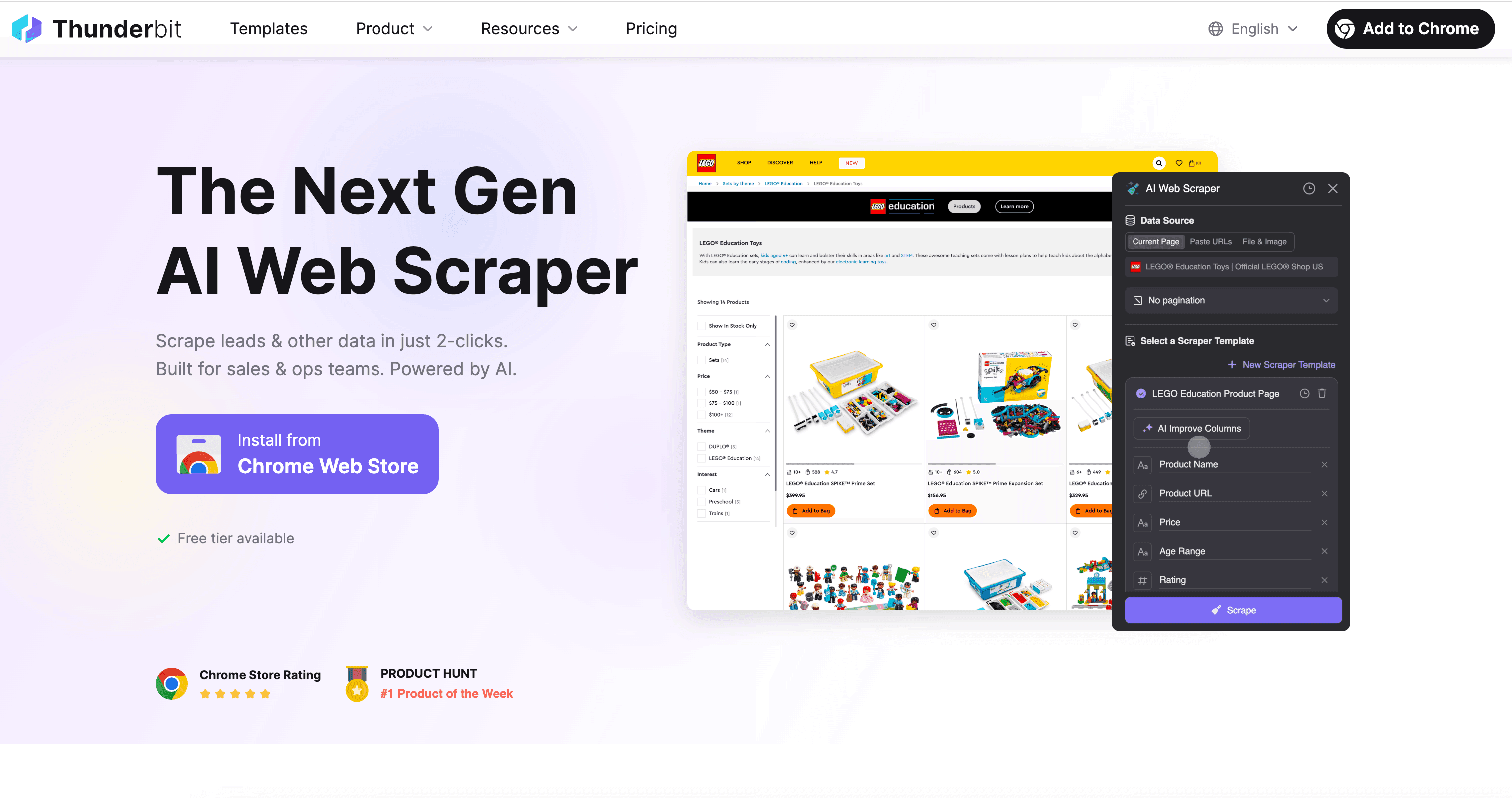 is my top pick, and not just because I helped build it—it’s because it’s the tool I wish I’d had back when I was drowning in job board tabs.
is my top pick, and not just because I helped build it—it’s because it’s the tool I wish I’d had back when I was drowning in job board tabs.
Why Thunderbit Stands Out
No-Code, Two-Click Setup:
Thunderbit is built for HR teams, not engineers. You just open a job page, click “AI Suggest Fields,” and our AI scans the page to propose which data fields to extract (job title, company, location, salary, description, etc.). Tweak or accept the suggestions, then click “Scrape.” That’s it. No selectors, no scripts, no templates to build. It’s so easy, I’ve seen HR managers go from zero to scraping in under a minute.
AI That Understands Any Job Board:
Job boards and career sites come in all shapes and sizes. Thunderbit’s AI “reads” the page like a human, so it works whether you’re scraping a standard ATS-powered site like or a custom-designed page like .
- On Netflix’s job page, Thunderbit auto-suggests fields like “Job Title,” “Location,” “Team,” and splits out responsibilities and requirements if they’re labeled.
- On OpenAI’s page, where sections are called things like “You might thrive in this role if you…,” Thunderbit recognizes that as requirements and unifies it with similar fields from other sites.
Post-Processing Superpowers:
Thunderbit doesn’t just grab data—it cleans, labels, translates, and summarizes it, too. Imagine scraping 10,000 job pages and having each one summarized like ChatGPT just read it for you. Some examples:
- Salary Normalization: If one posting says “$4,000/month” and another says “£50,000 per annum,” Thunderbit can convert both into annual USD for easy comparison.
- Field Merging: Whether a site says “What we are looking for” or “You might thrive in this role,” Thunderbit merges them into a single “Requirements” column.
- Translation: Scraping jobs in multiple languages? Thunderbit can translate on the fly.
- Summarization: Get a one-sentence summary of each job description for quick scanning.
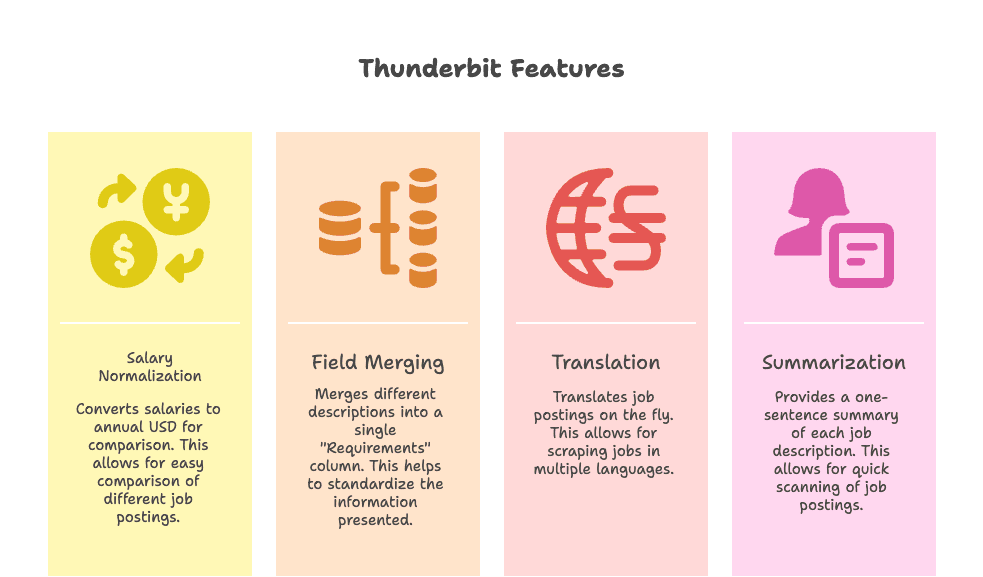
Export and Integration:
Export your data to Excel, Google Sheets, Airtable, or Notion in one click. Thunderbit even uploads images to Notion and Airtable if you scrape them.
Subpage Scraping:
Need to scrape all job listings from a company? Thunderbit’s “Scrape Subpages” feature will visit each job’s detail page and pull the info for you—no extra setup.
Real-World Scenario:
An HR manager needs to gather all “Machine Learning Engineer” jobs from Netflix, OpenAI, Google, Microsoft, and Amazon. With Thunderbit, she opens each site, lets AI suggest fields, scrapes the listings, and gets a unified table in minutes. The AI ensures all columns (Title, Location, Department, etc.) are consistent, even if each company’s site looks different.
For a deeper dive, check out .
2. Octoparse: Visual Job Scraping Without Coding
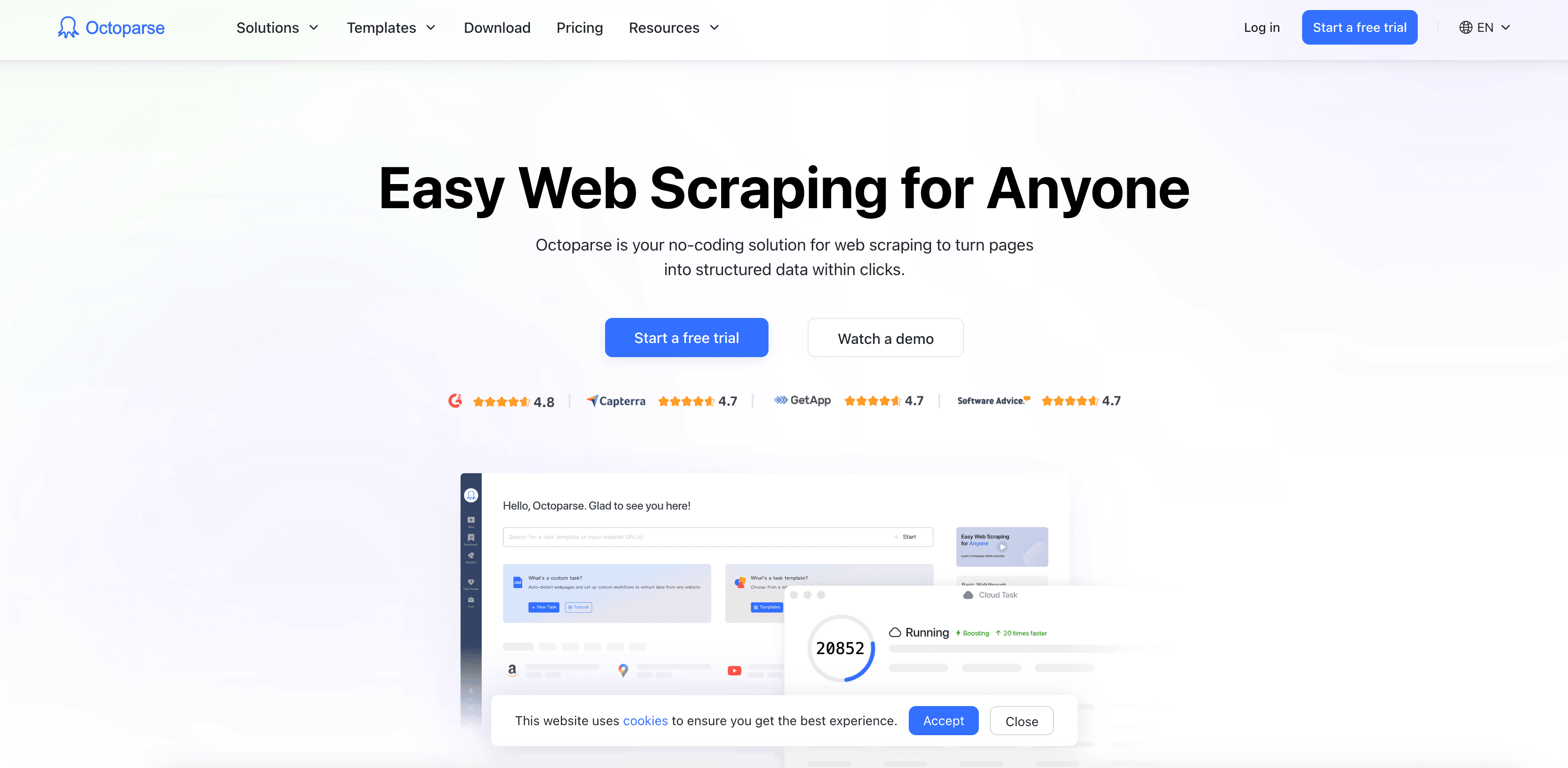 Octoparse is a visual web scraping tool with a drag-and-drop interface. It’s a favorite among users who want more control but don’t want to code.
Octoparse is a visual web scraping tool with a drag-and-drop interface. It’s a favorite among users who want more control but don’t want to code.
- Visual Workflow Editor: Point-and-click to select job listing elements; configure pagination and dynamic content (like infinite scroll).
- Cloud Automation: Schedule scraping tasks to run on Octoparse’s servers, so you don’t have to keep your computer on.
- Templates: Pre-built templates for popular job boards like LinkedIn and Indeed.
- Data Export: Export to CSV, Excel, JSON, or use their API for integration.
Strengths:
Great for HR analysts who want flexibility and can spend a bit of time setting up each site. Handles dynamic sites well.
Limitations:
There’s a learning curve for advanced tasks, and the interface can feel complex. Paid plans start around $99/month.
3. Apify: Flexible Job Scraping for Developers and Teams
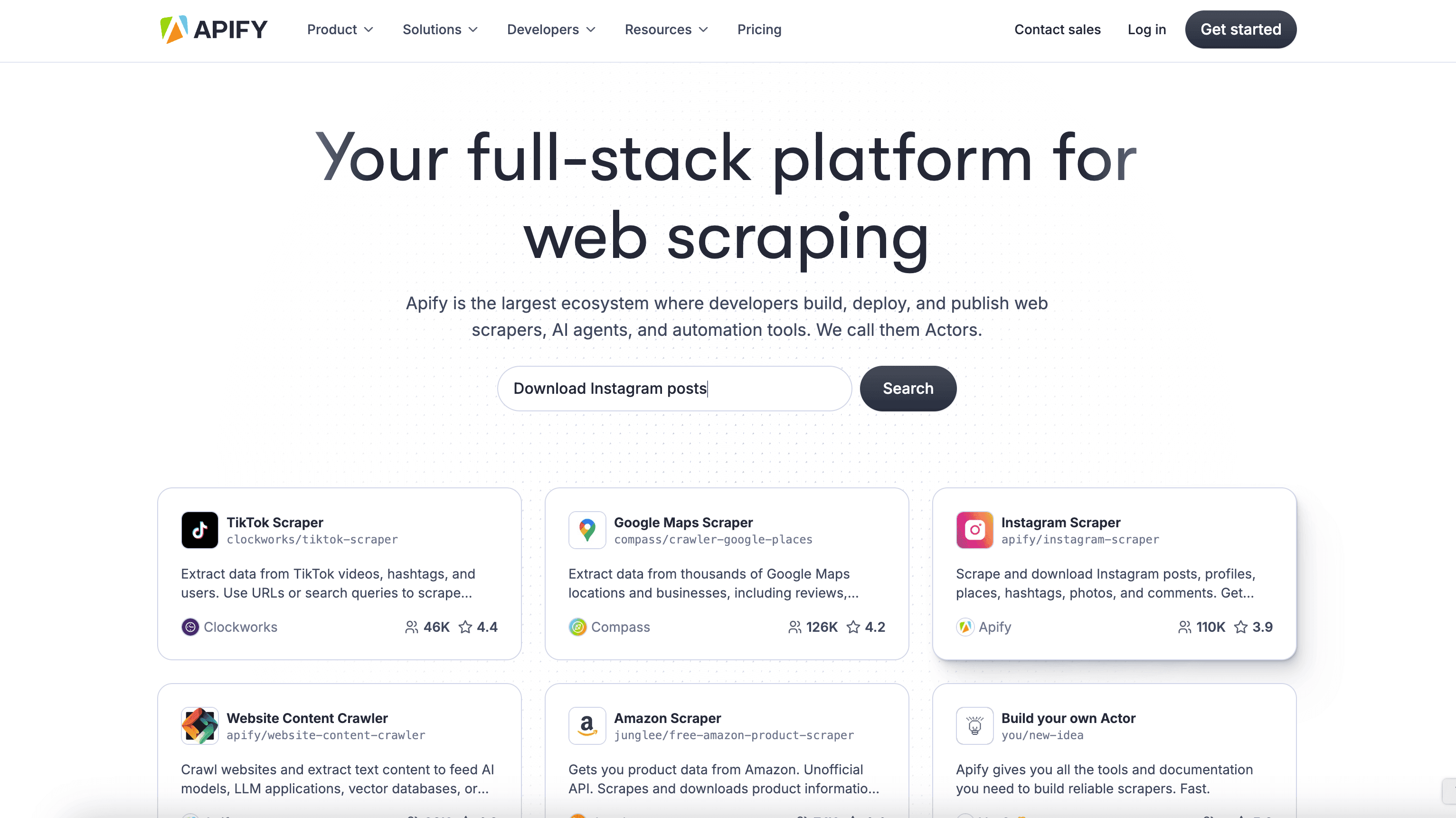 Apify is a hybrid platform with both ready-made “actors” (pre-built scrapers) and the ability for developers to code custom scrapers.
Apify is a hybrid platform with both ready-made “actors” (pre-built scrapers) and the ability for developers to code custom scrapers.
- Ready-Made Actors: Plug-and-play scrapers for LinkedIn, Indeed, Glassdoor, and more.
- Customizable: Developers can write scripts for niche or custom sites.
- Scalable Cloud Infrastructure: Run multiple scrapers in parallel, manage proxies, schedule recurring jobs.
- API Integration: Retrieve data as JSON, CSV, or via webhooks.
Best for:
Medium to large teams with some developer support, or anyone needing to scrape many sites at scale. Paid plans start around $49/month.
4. PhantomBuster: Automate LinkedIn and Social Job Scraping
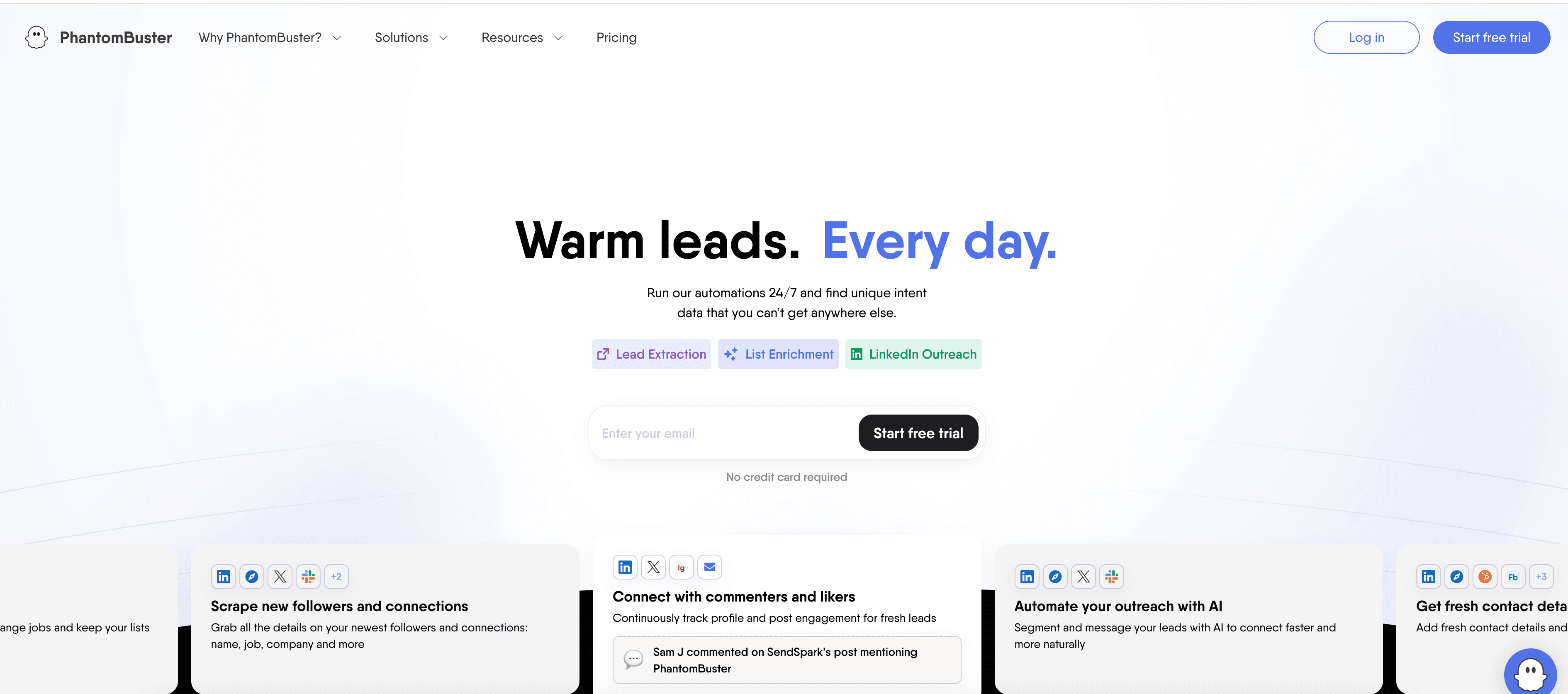 PhantomBuster specializes in automating actions on social networks, especially LinkedIn.
PhantomBuster specializes in automating actions on social networks, especially LinkedIn.
- LinkedIn Job Scraper: Extract job listings using your LinkedIn session.
- Cloud-Based Scheduling: Run automations on a schedule; chain together actions (e.g., scrape jobs, then scrape job posters).
- No Coding Needed: Just configure via forms.
Strengths:
Perfect for recruiters focused on LinkedIn and social recruiting. Integrates with Google Sheets and Zapier.
Limitations:
Limited to what their “Phantoms” support (mostly LinkedIn and similar platforms). Paid plans start at $60/month.
5. Bright Data: Enterprise-Grade Job Scraping with API Power
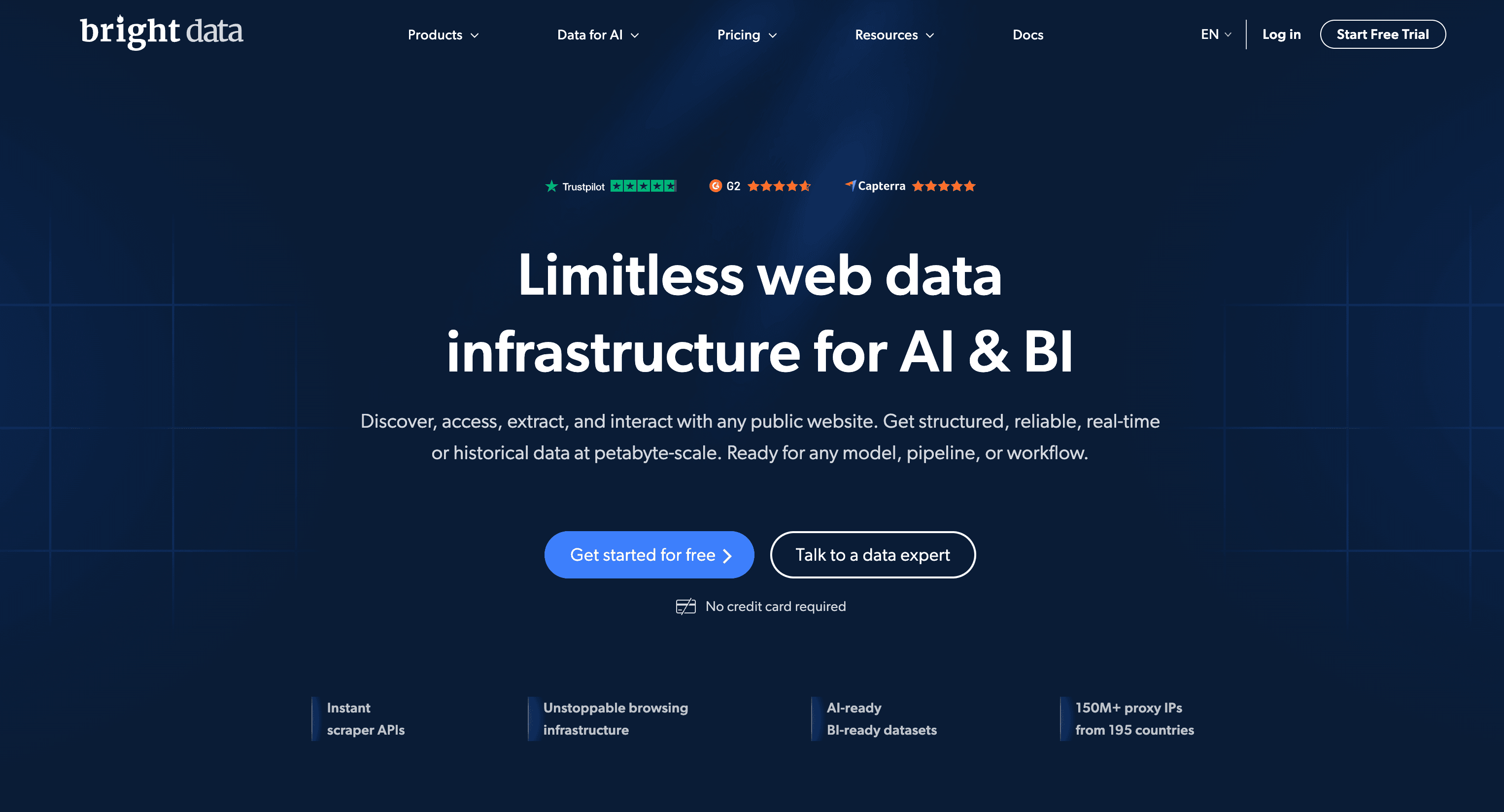 Bright Data is the heavy hitter for enterprise-scale scraping.
Bright Data is the heavy hitter for enterprise-scale scraping.
- Massive Proxy Network: Avoids blocks and rate limits, can scrape virtually any site.
- Web Scraper API: Pre-defined scrapers for LinkedIn, Indeed, Glassdoor, and more.
- Bulk and Real-Time Data: Handles thousands of URLs at once, delivers data quickly.
- Advanced Filtering: Specify exactly what fields you want.
Best for:
Large organizations or data teams needing huge volumes of data. Pricing is usage-based (e.g., $0.001 per record), so it can get expensive at scale.
6. DataMiner: Browser Extension for Quick Job Board Scraping
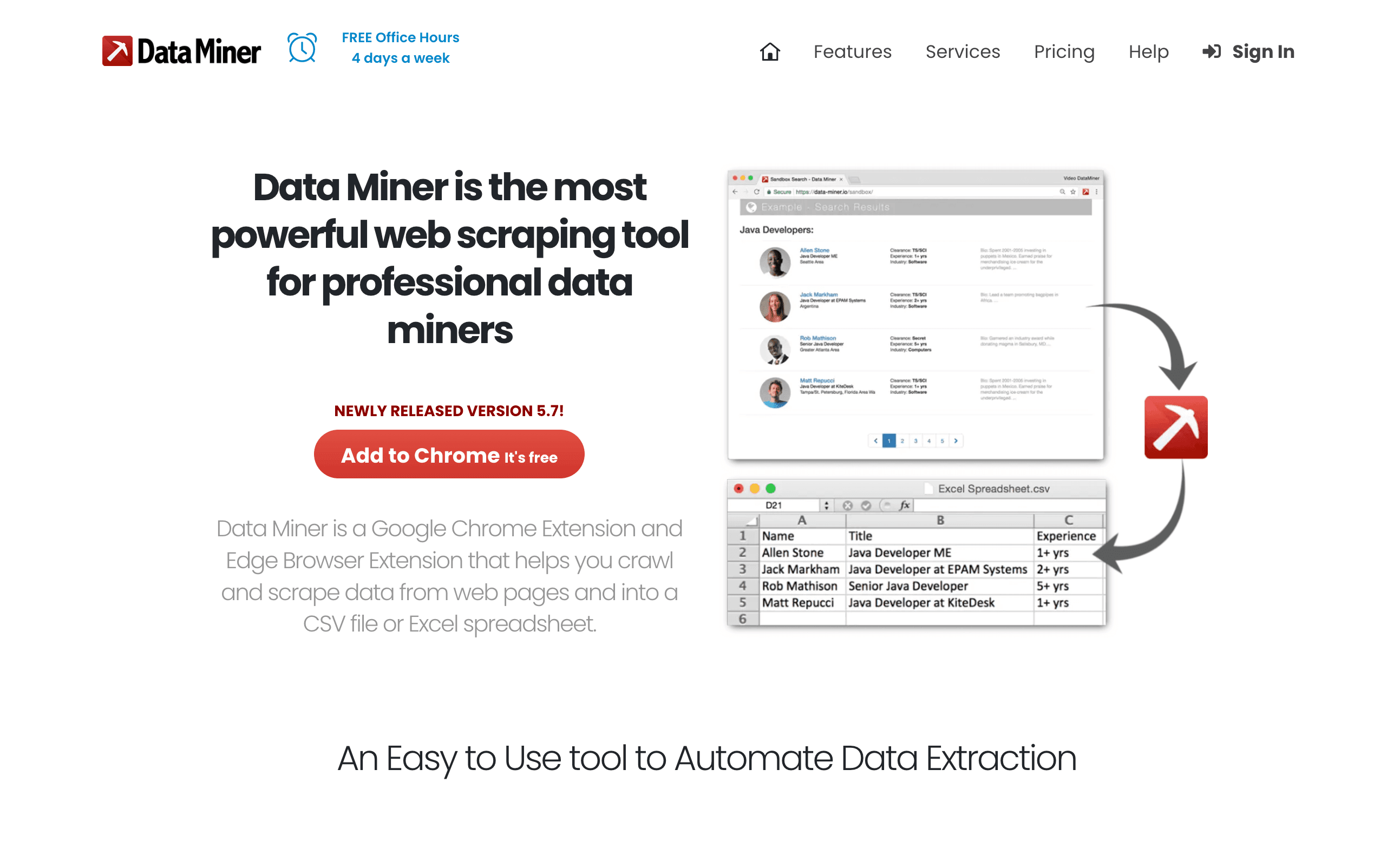 DataMiner is a lightweight Chrome extension for scraping data directly from web pages.
DataMiner is a lightweight Chrome extension for scraping data directly from web pages.
- One-Click Scraping: Apply or create a “recipe” to extract data from the current page.
- Public Recipe Library: Hundreds of pre-built recipes for popular sites.
- Export: Download to CSV or Excel instantly.
Strengths:
Great for quick, one-off scrapes by non-technical users. Free tier available; paid plans start at $20/month.
Limitations:
Not built for large-scale or automated scraping—manual operation only.
7. ParseHub: Point-and-Click Job Scraping for Complex Sites
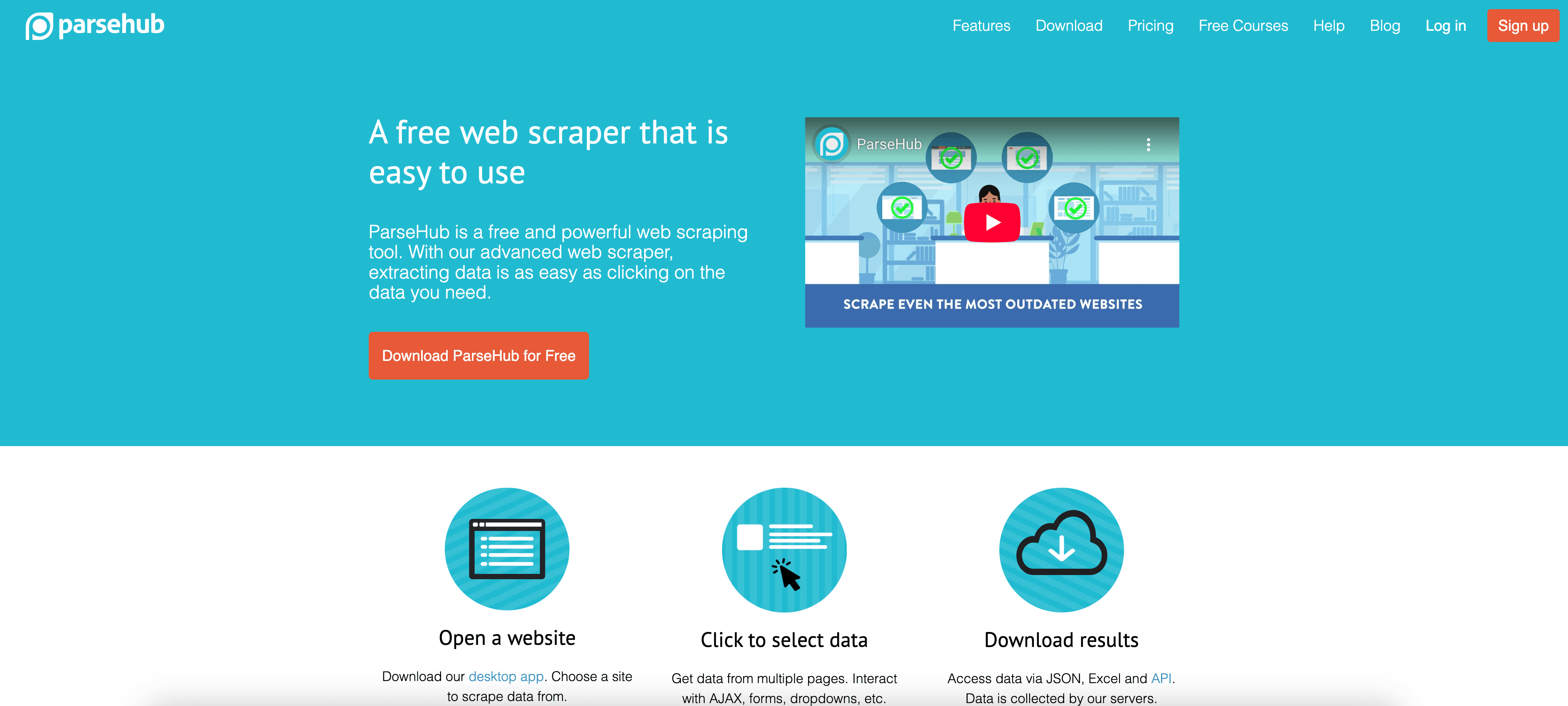 ParseHub is a desktop app for point-and-click web scraping.
ParseHub is a desktop app for point-and-click web scraping.
- Visual Project Setup: Click to select elements, set up conditional logic, handle pagination.
- Handles Dynamic Content: Works with JavaScript-heavy sites and infinite scroll.
- Desktop + Cloud: Design projects on your computer, run locally or in the cloud.
Strengths:
Good for mid-scale, custom scraping tasks—especially if you want a desktop tool.
Limitations:
No AI assistance for field detection; you define what to scrape. Paid plans start at $50/month.
8. Diffbot: AI-Powered Job Data Extraction at Scale
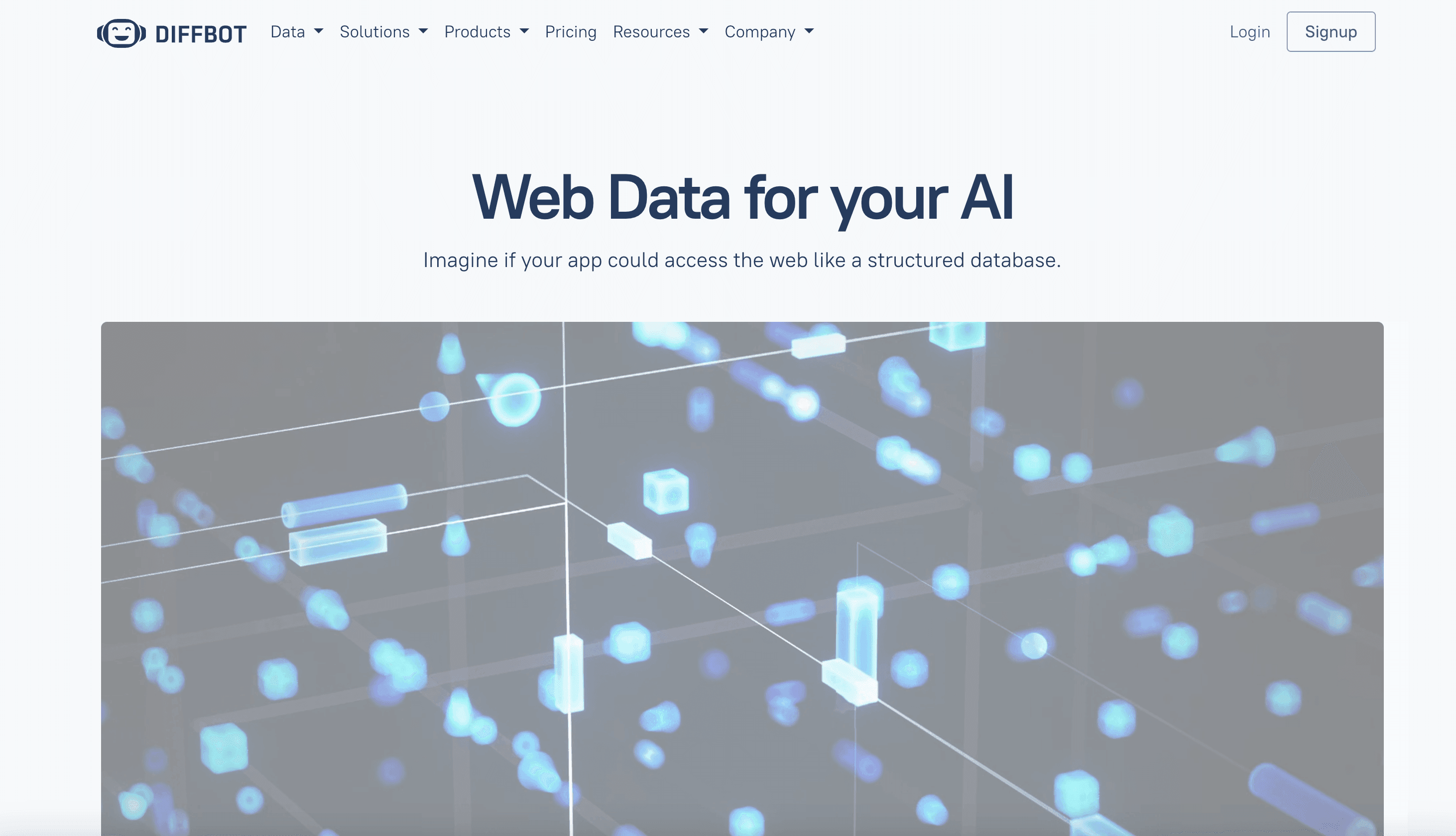 Diffbot is an API-driven platform that uses AI to structure content from any URL.
Diffbot is an API-driven platform that uses AI to structure content from any URL.
- Automatic Structuring: Feed it a URL, and its AI extracts job title, company, location, requirements, salary, and more.
- Bulk Crawling: Can process thousands of URLs, figure out which are job postings, and extract them.
- API Integration: Designed for developers and data teams.
Best for:
Enterprises or analytics teams needing to monitor hundreds of sites at scale. Pricing starts at $299/month.
Side-by-Side Comparison: Which Job Scraping Tool Fits Your Needs?
Here’s a quick comparison table to help you choose:
| Tool | No-Code Ease | AI Features | Supported Sources | Export/Integration | Pricing | Best For |
|---|---|---|---|---|---|---|
| Thunderbit | Excellent (2-click setup) | Yes (AI field detection, unification, translation, labeling) | Any website | Excel, Google Sheets, Airtable, Notion, CSV/JSON | Freemium | HR teams, recruiters |
| Octoparse | Good (visual designer) | Partial (pattern detection) | Multiple sites, templates for LinkedIn/Indeed | CSV, Excel, JSON, API | $99+/mo | Analysts, HR ops |
| Apify | Moderate (pre-built actors) | No (user sets fields) | Virtually any site | JSON/CSV, API, webhooks | $49+/mo | Dev teams, large-scale |
| PhantomBuster | Excellent (for LinkedIn) | Some (workflow automation) | LinkedIn, social | CSV/Excel, Google Sheets, Zapier | $60+/mo | Recruiters, growth hackers |
| Bright Data | Low (API, technical) | Yes (anti-blocking, templates) | Any site, enterprise scale | JSON, real-time feeds | Usage-based | Enterprises |
| DataMiner | Excellent (browser UI) | No | Any site in browser | CSV/XLS | $20+/mo | Quick, small jobs |
| ParseHub | Good (point-and-click) | No | Multiple, dynamic sites | CSV/Excel/JSON | $50+/mo | HR researchers |
| Diffbot | Low (API, devs) | Yes (AI extraction) | Any site | JSON, API | $299+/mo | Data teams, analytics |
For more details, see the .
How Thunderbit Makes Job Scraping Effortless for HR: Real-World Examples
Let’s see Thunderbit in action with two real-world examples: Netflix and OpenAI careers pages.
Example 1: Scraping Netflix’s Careers Page
Netflix’s job postings are pretty standard—sections like “Job Title,” “Location,” “Team,” and “Description.” Here’s how Thunderbit handles it:
- Click “AI Suggest Fields.” Thunderbit scans the page and suggests all the relevant fields.
- Click “Scrape.” Instantly, you get structured data: Job Title = Machine Learning Engineer, Location = USA, Remote, Team = Data & Insights, etc.
- Post-Processing: If Netflix lists a salary as “$4,000/month,” Thunderbit can normalize it to annual USD. Or, you can have Thunderbit summarize the job description in one sentence.
Example 2: Scraping OpenAI’s Careers Page
OpenAI’s job postings use unique headers like “You might thrive in this role if you…” Thunderbit’s AI recognizes this as requirements and unifies it with similar fields from other sites.
- Click “AI Suggest Fields.” Thunderbit proposes fields like “Job Title,” “Location/Team,” and “Requirements.”
- Click “Scrape.” You get a unified “Requirements” column, even though OpenAI uses a different label.
- Export: Send your data to Excel, Google Sheets, or Notion in one click.
Unified Output Example:
| Job Title | Company | Location | Team/Dept | Requirements | Description (Summary) |
|---|---|---|---|---|---|
| Machine Learning Engineer | Netflix | USA (Remote) | Machine Learning Platform | - MS/PhD in CS or related - 5+ years ML exp - Python | Develop and improve personalization algorithms for Netflix |
| Machine Learning Engineer, Integrity | OpenAI | San Francisco, CA | Applied AI Engineering (Integrity) | - Defend against adversarial attacks - AI security exp | Ensure OpenAI’s models are secure and misuse-resistant |
Thunderbit unifies the schema, so “You might thrive in this role if you…” and “What we are looking for” both become “Requirements.” No manual cleanup needed.
Subpage Scraping:
If you want all jobs from Netflix or OpenAI, Thunderbit can scrape the listing page, then visit each job’s detail page automatically.
Export:
Export to Excel, Google Sheets, Airtable, or Notion. Share with your team or import into your ATS.
Bottom line:
Thunderbit turns the wild west of job boards into a clean, analyzable spreadsheet—no technical skills required.
Choosing the Right Job Scraping Software: Key Considerations
Here’s how to pick the right tool for your team:
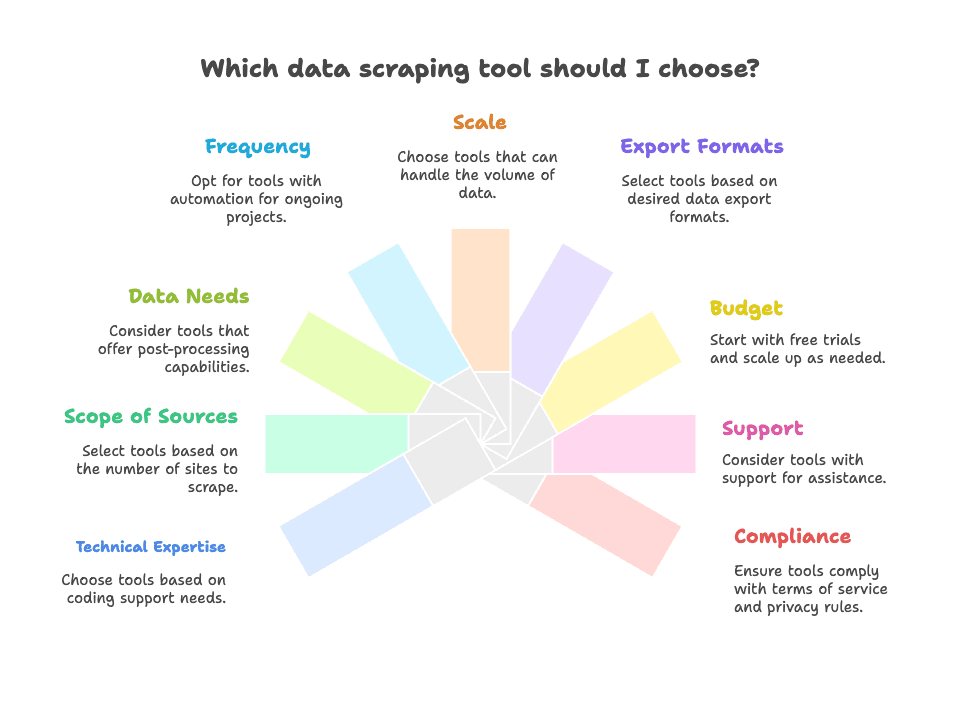
- Technical Expertise: No coding support? Go with Thunderbit, DataMiner, or ParseHub. Have a developer? Consider Apify, Bright Data, or Diffbot.
- Scope of Sources: Scraping a few sites? Thunderbit or Octoparse will do. Need to cover hundreds? Look at Diffbot or Bright Data.
- Data Needs: Need post-processing (like skill extraction, translation, or salary normalization)? Thunderbit and Diffbot excel here.
- Frequency: For one-off projects, any tool works. For ongoing, scheduled scraping, look for tools with automation (Thunderbit, Octoparse, Apify).
- Scale: Small volumes? Any tool. Huge volumes? Go with Bright Data, Diffbot, or Apify.
- Export Formats: Need Excel or Google Sheets? Thunderbit, DataMiner, PhantomBuster are convenient. Need JSON for a database? Diffbot, Apify, Bright Data are better.
- Budget: Start with a free trial or low-cost tool, then scale up as needed.
- Support: Need help? Thunderbit and most enterprise tools offer support; open-source or smaller tools rely on community forums.
- Compliance: Always follow the terms of service and privacy rules for the sites you scrape.
Often, teams use a mix: Thunderbit for most sites, PhantomBuster for LinkedIn, DataMiner for quick one-offs. That’s perfectly fine.
Conclusion: Power Up Your Recruitment with the Right Job Scraping Tool
Recruiting in 2025 is a data-driven game. With millions of job postings going live every day and HR teams under pressure to move fast, AI job scraping software is no longer a nice-to-have—it’s essential. These tools turn hours of manual work into minutes of actionable insights, helping you benchmark salaries, spot trends, and build your talent pipeline before the competition even knows what hit them.
Here’s the quick recap:
- Thunderbit is the easiest, most powerful no-code AI job scraper for HR and operations teams. It unifies, cleans, and enriches your data—no technical skills required.
- Octoparse and ParseHub are great for those who want more control and are willing to spend a bit more time configuring.
- Apify, Bright Data, and Diffbot are best for large-scale, technical, or enterprise needs.
- PhantomBuster is your go-to for LinkedIn automation.
- DataMiner is perfect for quick, small jobs.
The best tool is the one that fits your workflow and goals. If you’re ready to stop copy-pasting and start making smarter, faster hiring decisions, or test out another tool that caught your eye. You’ll be amazed at how much time—and sanity—you save.
Happy scraping, and may your next hire be your best yet.
Want more tips on web scraping, automation, and AI for HR? Check out the for deep dives, tutorials, and real-world stories from teams like yours.
FAQs
1. What is job scraping software and why is it useful for HR in 2025?
Job scraping software automatically extracts job postings from websites like LinkedIn, Indeed, and company career pages, turning unstructured listings into organized data. In 2025, with millions of listings live daily, HR teams use these tools to save time, improve accuracy, and make faster, data-driven hiring decisions.
2. How does Thunderbit simplify job scraping compared to other tools?
Thunderbit uses AI to auto-detect fields on any job page—no coding or setup required. You just click “AI Suggest Fields” and then “Scrape.” It also post-processes data by translating, summarizing, and standardizing formats like salary, making it especially user-friendly for non-technical HR teams.
3. Can job scraping tools handle multiple job boards and listing formats?
Yes. Tools like Thunderbit, Apify, and Bright Data support scraping from multiple job boards and custom career sites. Thunderbit’s AI adapts to different formats and merges varied content (like “What we’re looking for” or “You might thrive if...”) into unified, structured fields.
4. What are some common business use cases for job scraping?
Popular use cases include salary benchmarking, competitor hiring analysis, building internal job databases, and conducting skills gap assessments. For example, scraping thousands of job listings helps HR leaders identify trending roles and in-demand skills for proactive talent planning.
5. Which job scraping tool should I choose for my team’s needs?
It depends on your technical comfort, scale, and goals:
- Thunderbit: Best for no-code, fast setup, and AI post-processing.
- Octoparse / ParseHub: Great for visual control with some learning curve.
- Apify / Bright Data / Diffbot: Ideal for developer-heavy or large-scale operations.
- PhantomBuster / DataMiner: Best for LinkedIn or quick manual jobs. Start with the tool that aligns with your team’s workflow and scale from there.